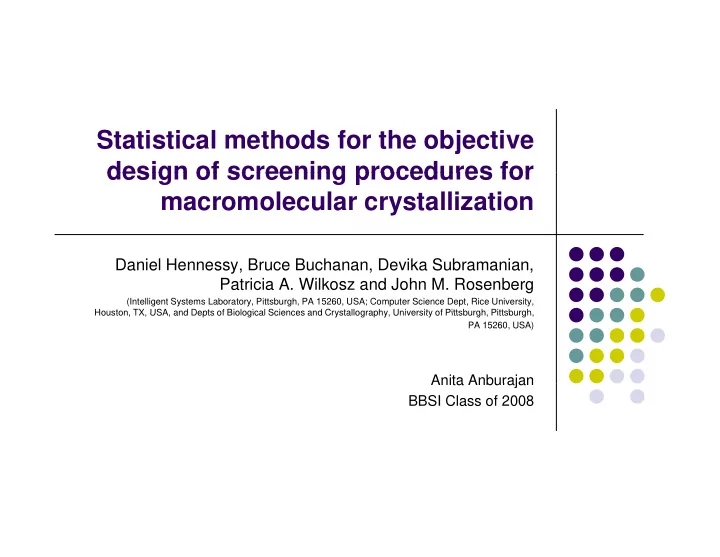

Statistical methods for the objective design of screening procedures for design of screening procedures for macromolecular crystallization Daniel Hennessy, Bruce Buchanan, Devika Subramanian, Patricia A. Wilkosz and John M. Rosenberg (Intelligent Systems Laboratory, Pittsburgh, PA 15260, USA; Computer Science Dept, Rice University, Houston TX USA and Depts of Biological Sciences and Crystallography University of Pittsburgh Pittsburgh Houston, TX, USA, and Depts of Biological Sciences and Crystallography, University of Pittsburgh, Pittsburgh, PA 15260, USA) Anita Anburajan Anita Anburajan BBSI Class of 2008
Crystallography Background C t ll h B k d “Crystallization is a little like hunting, requiring knowledge of y your prey and a certain low cunning..” Perutz p y g � Goal: � One converts a given macromolecule into a crystalline state with a high degree of internal order by manipulating i h hi h d f i l d b i l i environmental parameters to slowly reduce solubility. � Problem Characteristics: Difficulty in applying thermodynamic theory ‘at the bench.’ � Many variables with many possible values � Givens with limited predictive value � Strong interdependence amongst variables g p g � Limited time, material and human resources �
I t Introduction d ti � Past Methods: Past Methods: � Carter & Carter (1979) � Jancarik & Kim (1991) Jancarik & Kim (1991) � Samudzi et al . (1992) � Use of BMCD (Biological Macromolecular Use of BMCD (Biological Macromolecular Crystallization Database) � Discussed Method: Di d M th d � Using a Bayesian approach, we look for ‘patterns of crystallization ’ of crystallization.
M th d Methods � A Macromolecular � A Macromolecular Hierarchy Based on size and complexity � � Restructuring of the BMCD data BMCD data Data re-representation � Attribute Abstraction � Data Labeling � Data Subsetting �
M th d Methods � Statistical Analysis of BMCD � Via Student’s t-test – compares the means of the numeric attributes (pH, temperature and macromolecular concentrations) between different macromolecular classes. Robust against non-normal populations. � Probabilistic Screen Design – rationale � Applying BMCD data as directly and objectively as possible. ibl � An extension and combination of partial factorial and sparse matrix approaches. p pp � Based on previous experience and anecdotal evidence.
P Program Description D i ti Procedure: � Input parameters for � crystallization into User interface for Probabilistic Screen Design program Given the entered � parameters, program selects set of trials best suited. The user specifies the number � of desired trials, generated by Carter & Carter algorithm. For each trial, necessary � frequencies are extracted from the database and probability of success is b bilit f i computed.
C Crystallization Notebook t lli ti N t b k � Functions: � Functions: Recording and archiving � Tools for performing chemical � and related calculations and related calculations � Features Display in the format of entire Di l i th f t f ti � tray for easy readability Including: Phase diagram � display of results; flexible entry display of results; flexible entry of recipe/concentration data; mass editing; ‘default; tray setups; Grid Screen wizard; printed output i t d t t
Probabilistic Screen Design - probability computation b bilit t ti The probability that the diffraction limit is under the threshold given specified d th th h ld i ifi d values for the crystallization variables : Can we assume independence amongst Crystallization parameter dependency graph. any of the variables? any of the variables? With each parameter computed as such : First operand in numerator Second operand in denominator is analogous.
R Results and Discussion lt d Di i The Student’s t-test supports pp � there are several highly significant differences in the distributions of temperature and/or pH in different classes. p Results support ‘patterns of � crystallization’, however results provide little guidance ‘at the provide little guidance at the bench.’ Goal of software is to identify y � probable crystallization conditions for a given macromolecular class and to guide experiments toward g p those conditions.
R Results and Discussion lt d Di i � Striving for objectivity in future versions of the Striving for objectivity in future versions of the program � Selection bias / Human behavior � Selection bias / Human behavior � (ie. Success at 294 K vs. 277 K) � Consideration of isoelectronic point � Consideration of isoelectronic point � Failure data � How effective is Probabilistic Screen Design ?
Evaluation of Probabilistic S Screen Design D i � 10 Test Proteins � 10 Test Proteins � Evaluation Criteria � Compare effectiveness of Probability Screen Design with: � Compare effectiveness of Probability Screen Design with: � Commercial Screen: Hampton Screen I & II � Routine Protocol: Published Grid Screen Quality Class Probabilistic Crystal Screen Grid Screens Screen Design Screen Design I & II I & II Scoring: 1 to 5 1 = Clear (Very Bad) (BCR) (Sparse Matrix) 2 = Precipitates (Bad) 5 3 6 4 3 = Microcrystal / Shower (Good) 5 + 4 10 7 5 4 = Small / Poor Crystal (Very 5 + 4 + 3 5 + 4 + 3 10 10 8 8 6 6 Good) Good) 5 = High Quality Crystal (Hooray!)
? Questions? ti Q
Acknowledgements t John Rosenberg John Rosenberg l d Dan Hennessy Judy Weiber A k
Recommend
More recommend